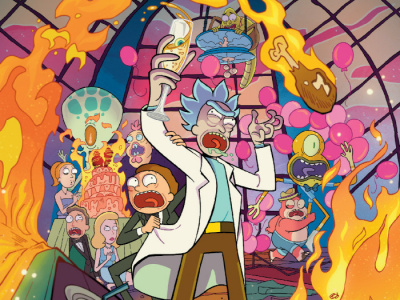
The release of Saga #12 has brought into the public eye the issues that retailers, including digital retailers, face when making decisions about retailing comics with sexual content. The big news today was in a blog post from comiXology CEO David Steinberger, who said that Brian K. Vaughan’s announcement on Tuesday that Apple had banned Saga #12 from the app store (see “Apple Bans ‘Saga’ #12 from iOS Apps”) was incorrect; the decision not to release Saga on iOS platforms was made by comiXology based on the explicitness of the content and the company’s understanding of Apple’s policies regarding content. It was not related to the sexual orientation of the characters, which the post called “a completely irrelevant consideration.”
Steinberger also revealed that “After hearing from Apple this morning, we can say that our interpretation of this policies was mistaken,” and that Saga #12 would be made available in the app store. That new interpretation is apparently being applied retroactively, as Image’s Sex #1, which had previously not been sold in the app store, is available now, as is Saga #12. "We apologize to Saga creator Brian K. Vaughan and Image Comics for any confusion this may have caused," Steinberger said.
Vaughan also released a statement, in which he apologized for saying that Apple had banned the book from its apps. “I’m truly sorry,” he said. “I never thought either company was being homophobic, only weirdly inconsistent about what kind of adult material was permissible. I’m grateful that the situation was cleared up so quickly, and I’m delighted I can go back to reading smutty comics on my Retina Display iPad.”
Exactly where Apple’s lines are drawn, and the understanding of those lines by its clients, was clearly a problem in this case. It seems to have been resolved in the direction of free access to the content, which is explicit beyond what an R-rated movie would include. The comiXology and Image apps are both rated 17 and up.
Some other retailers have expressed concerns over the content, as for example in this Talk Back (see “Peter DeFelice of Pyramid Comics and Cards on ‘Saga’ #12”). Each retailer has to make his or her own decision as to whether to sell sexually explicit content in his or her store, and also, and perhaps most importantly, to customers of which ages.
Most issues of Saga would draw an R rating if they were movies, so would theoretically be appropriate for 17-year-olds. But some issues, specifically #12, and also #4, have content that goes beyond what would be seen in an R movie. For some retailers, that makes those issues something they don’t want to sell in their stores because of lease requirements, their personal beliefs, the expectations they’ve set for their customers about what kind of content they’ll find there, or for other reasons. That’s problematic with a series in which the levels of explicitness vary. Does a retailer that doesn’t want to carry X-rated merchandise stock the other issues of the series? Or eliminate the whole series to avoid disappointing regular customers who would then face gaps in what they could buy from that retailer?
And for those retailers that choose to carry all issues of the series, similar questions arise as to what ages to sell the various issues. The choices are to restrict sales of all issues to customers 18 and up; to restrict sales on only the more explicit issues to customer s 18 and up and sell the other issues to younger customers, perhaps 17 and up or perhaps younger; or to sell all issues of the series to customers 17 and up or younger.
We spoke to Comic Book Legal Defense Fund executive director Charles Brownstein about the legal issues of the age question. Brownstein had provided us with the Fund’s statement on Saga #12 (see “Charles Brownstein of the CBLDF on ‘Saga’ #12”), which argues that the material is protected by the First Amendment. Courts apply the Miller test, which has three standards that have to be met for content to be obscene:
1.whether the average person, applying contemporary community standards, would find that the work, taken as a whole, appeals to the prurient interest;
2.whether the work depicts or describes, in a patently offensive way, sexual conduct or excretory functions specifically defined by applicable state law; and
3.whether the work, taken as a whole, lacks serious literary, artistic, political, or scientific value.
According to Brownstein, for material sold to minors which could run afoul of state-level “injury to minors” statutes that prohibit selling sexually explicit material to minors, the same three prongs must be applied, as for minors, for the statute to be constitutional. The key is the “community standards” as they apply to minors in the retailer’s community.
The biggest issue for retailers may be awareness of the content. We went through Saga #12 three times looking for the content that had raised the explicitness issue and didn’t find it until it was pointed out to us. All of the issues of Saga are solicited as for mature readers, but since the level of explicitness varies, that may not be enough information to help retailers make their decisions about how to handle each issue. And expecting retailers to spot all content that could be of concern when new books arrive, especially if it’s as subtly placed as the explicit content in Saga #12, is probably unrealistic.
None of these are new issues. The existence of multiple layers in the digital channels creates some new complexities in how policies work, as was demonstrated in the Saga #12 situation. But the basic issues of complete information at the time of solicitation, matching the solicitation info in the product that’s eventually shipped, and the need for retailers to have clear policies on how to handle adult material remain the same.
Retailers, publishers, creators—have thoughts on these issues? Share them—click on this link for how.
--Disclosure: ICv2 has a business relationship with comiXology as a representative for its Retailer Tools; ICv2 CEO Milton Griepp also serves on the board of comiXology.







